No, I’m not talking about dual income; no kids. I’m talking about the softest and most precise shots you’ll ever use in pickleball. If you’re a beginner you’ve probably heard of it in passing. Dinking is one of the most important parts of any player’s pickleball game. And considering that is one of the most important skills to master. I’m going to teach everything you need to know about dinking in pickleball today.
I know that at first glance, dinking can seem complicated. I understand that. But once you break it down it becomes easier to understand. It’s important to have a principled and mechanical understanding of how dinking works and what the point of it is. That’s where we’ll begin today.
If you’re a beginner, I highly encourage you to read through this part. My hope is that I persuade you to focus more on your dinking game. But if you want to skip this part, then feel free to scroll down to the “all about the dink shot” section.
What’s the point of the dink?
Before I get into how to dink well, I need to explain why dinking exists in the first place. Believe me, it’s for a very good reason. Here’s the main point about dinking that I want you to hold on to.
In pickleball, dinking is about extending the game as long as possible so your opponent makes a mistake sooner than you do.
Who knew procrastinating could be so useful!
This is the point of the dinking game in pickleball. To force your opponents to return awkward or difficult shots. The longer you extend the game, the more likely your opponent is to mess up.
In reality, there’s really no such thing as a game-winning dink. It can happen, but not very often.
How you win the game with a dink is typically how your opponent responds to it. If they respond to it poorly, that’s when you take advantage of it and “put away” the ball for the win. But notice how it’s not necessarily the dink that won the point. It was the dink that set up the opponent to make it all happen. All you have to do is capitalize on their mistake. We’ll talk more about setups and strategy later.
The other aspect of the dinking game that needs mentioning is that dinking ruins your opponent’s ability to drive the shot back at you. In pickleball, the net is about 3 feet high. Any ball that bounces higher than 4 feet can easily be driven or slammed back to you.
That means you lose.
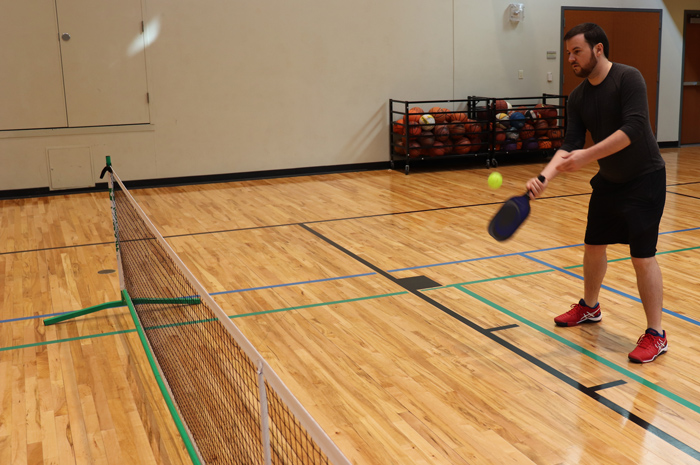
Try to stand as close to the kitchen line as you can when dinking.
But here comes the dink to the rescue! By dinking the ball lightly over the net, you reduce the height the ball bounces and by extension reduce the chances of your opponent smacking the ball hard at you. When you look at it this way, dinking becomes purely a defensive mechanic. It doesn’t make you win, but it keeps you from losing.
This is why developing your dinking game is so important. If you dink the wrong way, your opponent will punish you for it.
All about the dink
Let’s get into it, shall we? The dink stroke is a simple, straightforward action that is designed to be soft and precise. Here’s the cool part though, you can use whatever kind of stroke you want. If you want to hit it from the side, you can. If you want it to be purely underhanded, you can do that too.
Do whatever is comfortable for you!
The stroke is pretty simple, but the main thing to keep in mind here is finesse. Remember, the whole point of a dink is to force your opponents to make a mistake and to keep them from driving the ball back at you. This means that the harder you hit a dink, the more likely this is going to happen. Keep it soft!
Volley or groundstroke?
Before we get into the specific dinking shots that you can make, we need to go over something very specific.
Before you dink a ball, you need to notice whether or not the dink is going to be a volley or a groundstroke. In case you’re new to the pickleball world, a volley is a ball hit out of the air and a groundstroke is a ball hit after it has bounced. The result of a shot will be different depending on whether it’s a volley or a groundstroke.
In general, if you volley a ball, it will bounce off the face of your paddle faster and will travel further. On the other hand, a shot after the ball has bounced (a groundstroke) will travel shorter.
The reason this happens is simple. The faster the ball is traveling when it collides with your paddle, the faster it will bounce off. It’s just physics. But when the ball bounces off the floor, it loses a tremendous amount of speed. So when you execute a groundstroke on one of these balls, it’s going to go much shorter.
This is a crucial principle to understand in pickleball.
But we can use this principle with dinking as well. How hard you hit a dink back to your opponent is going to be based on, of course, the distance, but also whether or not it’s going to be a volley or a groundstroke. If it’s a volley, you have to be extra careful and soft. Remember, if you pop the ball up, your opponent will smash it and you’re most likely toast.
But if it’s a groundstroke, then you can hit it a bit harder. As you play more and experience longer dinking rallies at the net, you’ll get used to how these speeds work.
Cross-court dink
Ok, enough theory, let’s talk about some shots!
The cross-court dink is the most important dink shot to learn when it comes to dinking. This is a shot that you hit at an angle to the other side of your opponent’s court.
This is what a cross-court dink looks like:
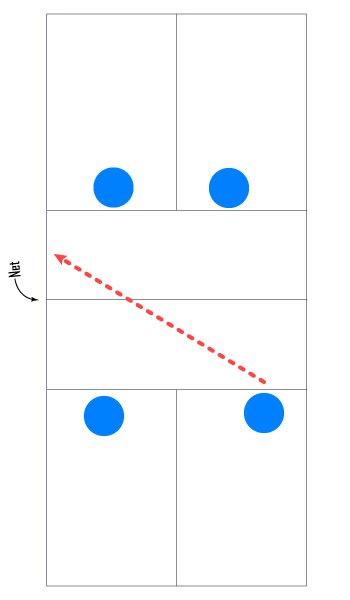
It’s simple in concept, but not in execution. The cross-court dink can be very hard to get used to.
There are many ways to perform a cross-court dink. You can do it underhanded or backhanded among other options. For simple cross-court dinks, I typically do them underhanded while facing the opponent. Facing your cross-court opponent allows you to see your opponent, the ball and the net all at the same time.
But this can break down pretty quickly if your opponent makes a great cross-court dink that hits your kitchen sideline. In that case, you will have to make a semi-blind shot without being able to look at the net. This just takes practice. Or you could use a straightaway dink like I explain below.
In terms of where you should be hitting these dinks, the key here is to land the ball as close to the opponent’s sideline and as close to the net as possible. Check out this image:
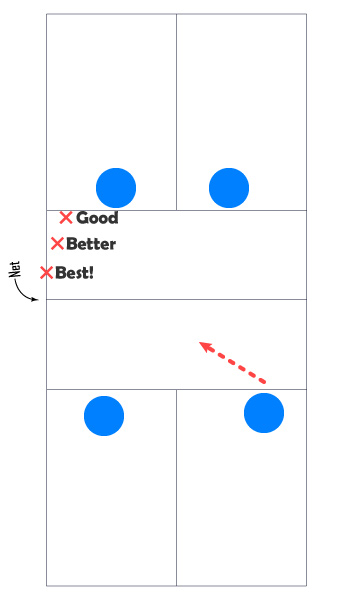
These are the spots that you should be aiming for. Always remember that the higher you hit it, the more opportunity your opponent will have to drive the ball back at your partner!
Where things can go wrong
Keep in mind that there is a downside to this if you’re playing against a very young or extremely experienced player.
If you’ve ever played against a young person, then you know how well they can play pickleball. Just their youth alone allows them to get balls that seem impossible to most people. I’m saying all this because when it comes to cross-court dinking, you have to be very careful. If you hit a great cross-court dink to their forehand, then they have a good chance of letting it bounce away, then hit it around the post to your backcourt. “Around the post shots” are brutal and young people do them all the time. So if you’re cross-court dinking to their forehand, be careful!
The straightaway
This is the most simple type of dink shot. The straightaway dink is simply a dink that goes straight ahead of you. These are the types of shots that you typically warm up with before a pickleball session.
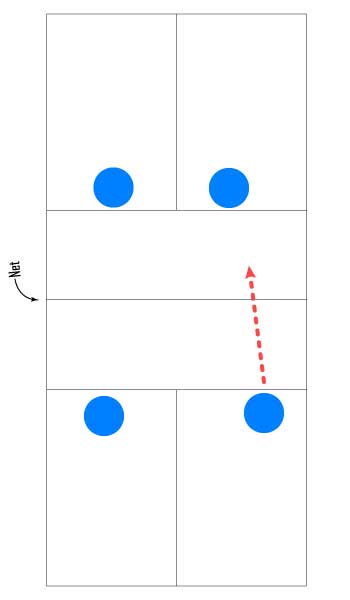
This dink shot is easy to do and doesn’t require much focus. But it has another purpose that I want to talk about.
The straightaway dink becomes important when it’s used as a fallback for a tough cross-court dink that was made by your opponent.
In pickleball, you will get into cross-court dinking battles, especially if you’re playing against advanced players. It’s possible to go back and forth with cross-court dinks up to 20 times in one rally. But sometimes the opponent will hit one with such an extreme angle that you may not be able to return the shot as a cross-court dink.
For this, you will need to use a straightaway dink in order to slow the game back down and keep in control. This is simply just a dink that goes straight in front of you but is much softer.
They key here is to not pop up the ball or hit it too long. That’s what your opponent wants you to do. Remember that the distance of a cross-court dink is over twice as long as a straightaway dink. You will have to hit the shot much softer than what you’ve been used to doing.
In general, if you think you can’t return a cross-court dink to your opponent, just hit a dink straight ahead of you and you’ll be in a much safer position.
Dinking strategy
Now that I’ve explained how to do the dink, what should you be accomplishing with the dink? Like I said earlier, dinking is about making your opponents make the mistake, not making you win the shot.
Dinking strategy in pickleball is all about manipulating the opponent’s position. Since pickleball is so frantic and fast, players have to respond quickly to well-placed shots. It’s those moments where you can take advantage and win the point.
The setup
This is one of the most fun and effective strategies to learn in pickleball. The setup is where you manipulate your opponent in order to leave a large opening in their court. Let me show you the progression of how this works.
- You or your partner executes a great cross-court dink.
- The opponent has to run sideways to get it but pops it up.
- You or your partner (whoever didn’t do the cross-court dink) smashes the ball where the opponent had run from.
This image will help you visualize this.
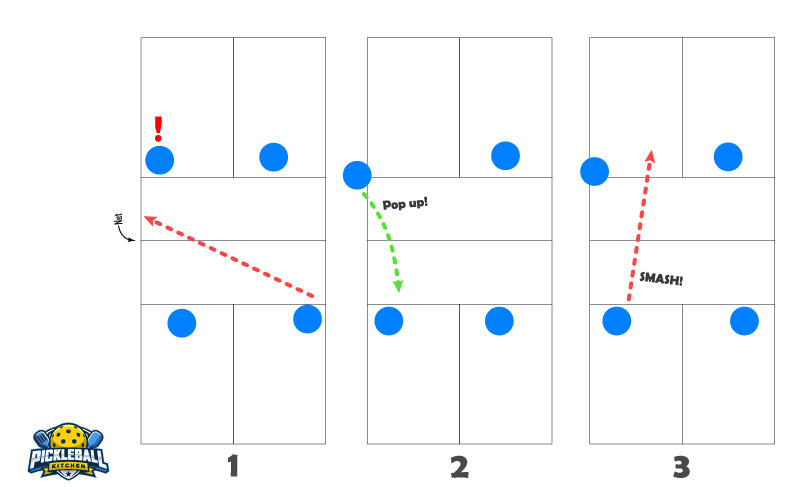
This is a brutally effective strategy that works almost everytime. Sometimes the other opponent will get wind of this and will cover for their partner, but that just means that they’ve also left their side of the court exposed as well. Practice this strategy as much as you can. It’s one of the best in pickleball.
The dinking mindset
Here’s where things get a little weird. Half of the dinking game is about technical skill. The other half is mind games and emotional control. I know that sounds weird, but bear with me.
The technical side of dinking is simple. Hitting the ball the right way isn’t that hard. But controlling your mind while dinking is another story. Let’s talk about a few concepts.
Patience
Patience is a term that gets thrown around a lot when you play advanced pickleball. It has to do with players executing a shot too early resulting in an easily avoidable mistake.
A common example that you see all the time is when an opponent will make a great dink that you think you can volley back to them. You stick your paddle out into the kitchen to volley it back over, but it hits the tip of your paddle and goes right into the net. You see this all the time. I’ve done it too.
This is an unforced error that could have been avoided with a healthy dose of patience. For dinks like this, if there’s any doubt that you can’t get a shot like that, just back off and wait for the ball to bounce instead. You have a far greater chance of returning a groundstroke dink than trying to reach into the kitchen. It just takes patience!
Pickleball panics
I will probably write a separate article just about this subject, but I will give you a brief rundown here. The pickleball panics is that feeling you get when you lose control over your body and you start scrambling to make the shot. It happens to all of us. With dinking, it happens when the opponent has made a killer cross-court dink that has hit your sideline. Bad time to get the pickleball panics! To reduce the prevalence of this, here’s what you can do.
- It’s all about preparation. Anticipating the shot before it happens is the best way to prevent the pickleball panics
- Be in the ready position
- Make sure your feet are spread out and you’re ready to move!
Doing these things will help ensure that your mind and body are ready to return great shots made by your opponent.
Advanced dinking
If you’re a beginner that’s looking for some advanced dinking techniques then I have a few options for you.
Dinking conversions
A dinking conversion is when you return an opponent’s dink as a powerful drive. Sometimes an opportunity will come when a dink is a bit too high. And as you now know, dinking is about extending the game until they make the mistake. A dink that is too high is a mistake. When this happens, you must capitalize on it!
Don’t be the one that ends up making the mistake though. Focus on a great shot instead of hitting it as hard as you can. If you can, apply some topspin so that it doesn’t go out the baseline.
If you do it the right way, you have successfully converted their mistake into a point for your team!
Backhand or forehand dink spin
This is a very effective, yet very difficult shot to do. If you’re a beginner, don’t try doing this until you’ve mastered the cross-court dink.
Backhand and forehand dinks are pretty easy to do. You just push the paddle in the direction that you want the ball to travel in. But what if you want to add some spin to it? To add some spin, you have to cut the paddle downward without hitting it too hard. If you hit it too hard it will go screaming out the sideline. But if you hit it too soft it will go right into the net.
This creates a ton of spin at the ball that can catch your opponent off guard. If you create enough spin, the ball will bounce straight up and your opponent will have to lunge forward to get it!
Conclusion
That concludes my article about dinking in pickleball! Dinking is an incredibly important technique to learn in pickleball. I hope that I’ve given you a few things to work on.
How has your dinking game been lately? Got any drills or techniques to share? Use the comment section below to tell me about it!
Anuncie Aqui / Advertise Here
Sua marca para o mundo Pickleball! / Your brand for the Pickleball world!

 English
English  Spanish
Spanish  Portuguese
Portuguese  German
German  Italian
Italian  Japanese
Japanese  French
French  Polish
Polish  Russian
Russian  Netherlands
Netherlands  Hungarian
Hungarian  Turkish
Turkish  Videos
Videos  Pickleball Kitchen
Pickleball Kitchen



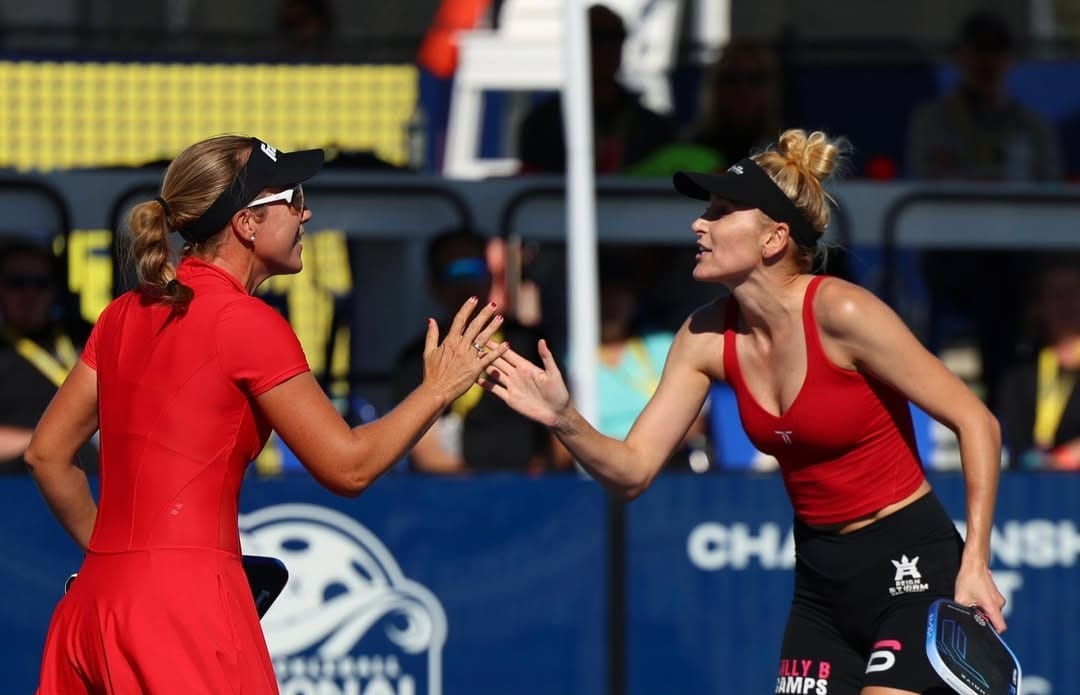




 English (US) ·
English (US) ·  Portuguese (BR) ·
Portuguese (BR) ·